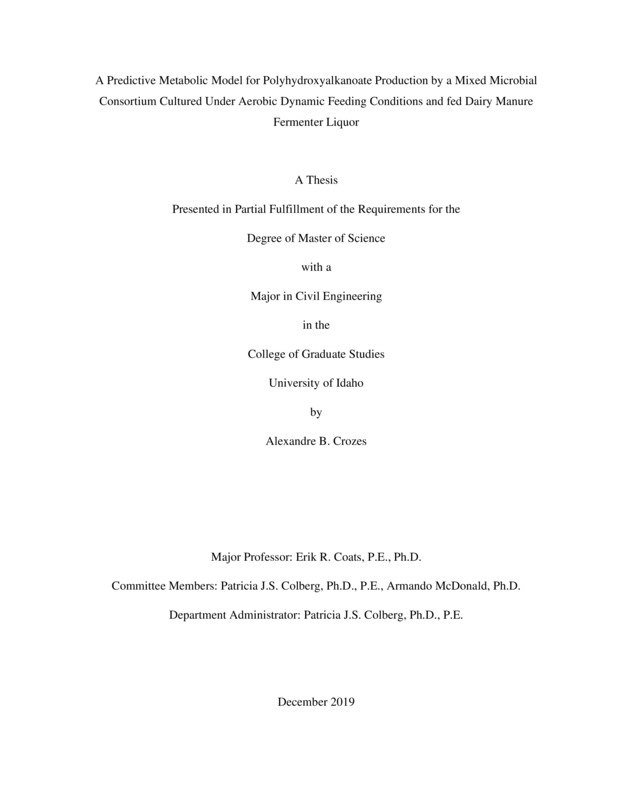A Predictive Metabolic Model for Polyhydroxyalkanoate Production by a Mixed Microbial Consortium cultured under Aerobic Dynamic Feeding Conditions and fed Dairy Manure Fermenter Liquor
Crozes, Alexandre. (2019-12). A Predictive Metabolic Model for Polyhydroxyalkanoate Production by a Mixed Microbial Consortium cultured under Aerobic Dynamic Feeding Conditions and fed Dairy Manure Fermenter Liquor. Theses and Dissertations Collection, University of Idaho Library Digital Collections. https://www.lib.uidaho.edu/digital/etd/items/crozes_idaho_0089n_11756.html
- Title:
- A Predictive Metabolic Model for Polyhydroxyalkanoate Production by a Mixed Microbial Consortium cultured under Aerobic Dynamic Feeding Conditions and fed Dairy Manure Fermenter Liquor
- Author:
- Crozes, Alexandre
- ORCID:
- 0000-0003-3052-3884
- Date:
- 2019-12
- Embargo Remove Date:
- 2022-09-03
- Keywords:
- 3-Stage ADF PHA Production Metabolic Model Polyhydroxyalkanoates
- Program:
- Civil Engineering
- Subject Category:
- Environmental engineering
- Abstract:
-
Global plastic use and disposal has become increasingly detrimental to the marine environment. The plastic problem is broad in scope with a complex solution; however, replacement of petro-plastics with bioplastics addresses the root of the issue, plastic accumulation. Polyhydroxyalkanoates (PHA) are biodegradable thermoplastics that are naturally produced by a variety of microorganisms and possess mechanical properties favorable for replacing fossil fuel derived plastics in single-use applications. Current PHA production processes utilize synthetic feed and pure cultures, a costly method that leaves economic viability to be desired. By employing an engineered PHA production process known as aerobic dynamic feeding (ADF), PHA can be synthesized by mixed microbial consortia (MMC) fed otherwise unused organic-rich waste streams. The inherent sustainability, coupled with reduced cost of substrate procurement and sterilization practices, place ADF configurations at the forefront of potentially feasible bioplastic solutions. Nevertheless, operational parameters that maximize volumetric productivity for a limited waste stream have yet to be defined. Research presented herein focused on the optimization of a three-stage ADF PHA production process by assessing the impacts of operational parameters, solids retention time (SRT) and organic loading rate (OLR). Additionally, a metabolic model was developed in order to describe ADF metabolism using complex substrate mixtures, ultimately providing insight for continued optimization efforts. Factorial-based evaluation of PHA production assessments led to the determination of a 2-day SRT and 20 Cmmol/L-d OLR as near-optimal culture enrichment operational criteria. Under said operation, the MMC converted nearly 100% of carbon to PHA resulting in an average maximum intracellular PHA accumulation of 38% (w/w). Furthermore, the metabolic model developed quantified the dynamic ADF microbial processes and led to accurate prediction of PHA composition for variable substrate mixtures.
- Description:
- masters, M.Engr., Civil Engineering -- University of Idaho - College of Graduate Studies, 2019-12
- Major Professor:
- Coats, Erik R.
- Committee:
- Colberg, Patricia J.S.; McDonald, Armando
- Defense Date:
- 2019-12
- Identifier:
- Crozes_idaho_0089N_11756
- Type:
- Text
- Format Original:
- Format:
- application/pdf
- Rights:
- In Copyright - Educational Use Permitted. For more information, please contact University of Idaho Library Special Collections and Archives Department at libspec@uidaho.edu.
- Standardized Rights:
- http://rightsstatements.org/vocab/InC-EDU/1.0/

